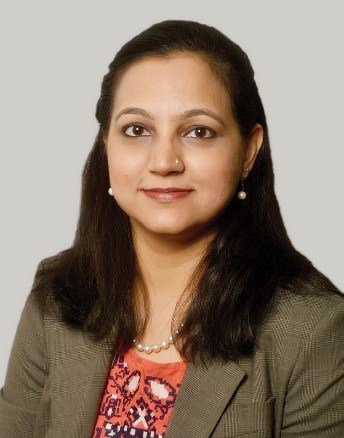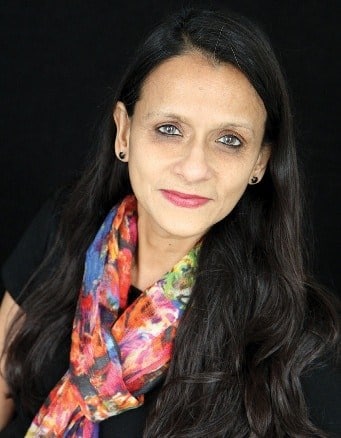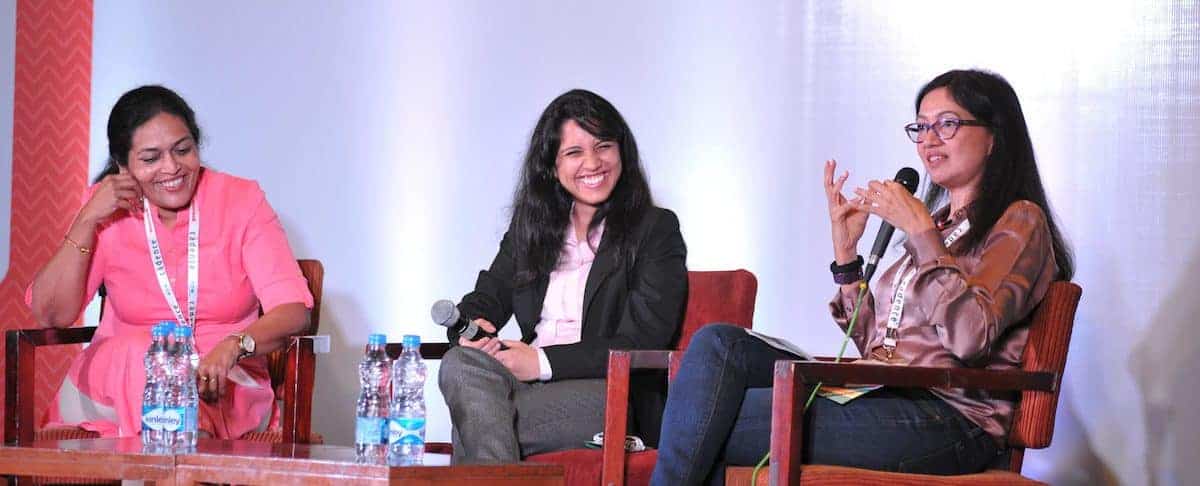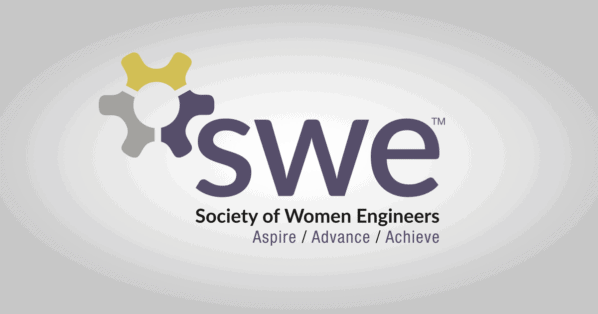This article was originally published in the Fall 2016 issue of SWE Magazine.
By Sandra Guy, SWE Contributor
The Society of Women Engineers’ WE conferences in Pune, India, in April and in Madrid, Spain, in May demonstrated how female engineers throughout the world savor expert insights and advice to help them navigate their demanding, ever-changing, and technologically sophisticated careers.
SWE’s second annual conference in Europe saw a 45.8 percent increase in attendance — from 144 at the 2015 event in Amsterdam to 210 this year — with sponsorship and organizational engagement more than doubling this year from the 2015 event, said Peter Finn, SWE’s deputy executive director and chief learning officer.
The European conferences have so far attracted mostly mid-career women with five to 15 years of work experience, Finn said.
Participants have been eager to learn how to innovate and get people thinking creatively throughout a company with a global presence, said Cristina Caballe, a SWE ambassador and executive director of client unit for IBM in Spain, Portugal, Greece, and Israel. Caballe, who tweeted her observations throughout the May 11-13 conference, participated in the plenary panel, “Learning as Fast as the World Is Changing.”
Learning from One Another

For Stueti Gupta, the WE India Conference proved just how far she has progressed in her aim to grow as a technical engineering leader, as she and 360 attendees networked with colleagues and delved into topics ranging from gender diversity to career advancement.
“We want women to grow in their careers, and forums such as the WE conference give women much-needed awareness so they can get ideas and work on solutions,” said Gupta, who started SWE’s international affiliate in the host city of Pune in 2015 and serves as its president.
Gupta, a SWE international ambassador since 2015, led a session at the conference about her experiences as a volunteer, including her membership in SWE as a graduate student at Cornell University, introducing men and women to SWE as the ambassador, organizing the John Deere India Private Limited SWE team in 2011 comprising herself and five female colleagues at the agricultural machinery maker, and working to create the international affiliate. Gupta has already started mentoring another SWE member in the full-capacity audience.
The conference, held April 7-8 and titled “Reach Out to Reach Up,” was SWE’s first full-fledged conference in India. The Society held a symposium there in 2012.
SWE Executive Director and CEO Karen Horting, CAE, says the conference in India is expected to become an annual event. “We see the need for women, no matter where they are in the world, to build their networks and interact with other women inside and outside of their organizations,” Horting said. “My takeaway is they can’t get enough of learning from one another.”
Gupta’s experiences at past SWE conferences and at the one in India show how networking plays out across the globe. She said she learned from leadership coach Jo Miller, CEO of Women’s Leadership Coaching Inc., at SWE’s 2013 annual conference in Baltimore how to grow her sphere of influence as senior lead engineer at John Deere India, leading model-based systems engineering efforts. Gupta earned a mechanical engineering master’s degree from Cornell.
She has worked to show how her expertise and abilities can increase her visibility in the six sources of influence Miller identified: positional, expertise, resources, informational, direct, and relationships. To further her progress, Gupta found her mentor, Pushpa Manukonda, the enterprise technology innovation strategy manager at John Deere headquarters in Moline, Illinois, who received a SWE Emerging Leader award at the Baltimore conference.
Gupta appreciates SWE’s role in encouraging her because she has found few female role models in core technical careers. “While I have found great mentors in male leaders, sometimes I want to look up to a female leader and think, ‘If she can do it, I can do it, too.’ It’s about being able to visualize yourself reaching to the top and learning how to find the right balance between work and family from others’ experiences.”
She has already learned to internalize a key aspect of workplace motivation by not presuming an opportunity at work is for a man or a woman and to speak up and sign up for tasks that can lead to greater responsibilities.
Gupta says SWE is vital in offering encouragement to women engineers throughout India. Cultural influences in India that give rise to conflict between women’s personal priorities and their technical careers lead most women to become stay-at-home moms or work in support functions. ‘We want to tell women, ‘There is a need to stay in the workforce.’ We have invested so much time in gaining expertise and experience,” Gupta said. “SWE’s forums show women they can have a candid dialogue with their manager or tweak a solution they’ve learned from a conference speaker because SWE has provided a reference point for inspiration.”
The SWE Pune affiliate in India counts 34 members from 12 organizations and businesses and is focused on raising awareness about SWE’s existence and the benefits of meeting other female engineers.
Gupta hopes to encourage women in India to meet others with similar expertise to talk about industry trends and attend future conferences to learn about cutting-edge topics such as developing an innovation ecosystem at work.
“If SWE programs can be leveraged in any part of the world, it would be helpful so women could realize their full potential,” she said. She said SWE’s leadership is evidenced by its role as the largest organization advocating women in science, technology, engineering, and mathematics (STEM) professions, and the phenomenal growth in SWE conference attendees, to more than 9,000 at its WE15 conference in Nashville, Tennessee, in 2015.
Elizabeth Bierman, FY15 SWE president and a principal systems engineer at Honeywell, said she was impressed that the attendees in India returned for the second day of the conference even though it was a state holiday.
“It was a very powerful message for SWE to see so many people cared enough to use their day off to come to the conference,” she said. “They all left saying, ‘We’re doing this again next year and we will bring more people.’ It’s the same after attending any SWE conference— the energy you feel knowing other women are out there, you have an employer that values sending you to the conference, and you have such a wonderful organization supporting you.”
Bierman said she was inspired that women in India wanted to talk about issues similar to those in the United States: meeting other women working in technical fields, finding work/life integration, challenging oneself to be the best one can be, and motivating the next generation to go into STEM careers.
“I was inspired by how open and honest the women were,” including discussing issues such as mothers and mothers-in-law pressuring the women to stop working. Bierman hopes for the women in India to find best friends in SWE as she has done and charge ahead with the reassurance they’re not alone.
The conference in India also had a majority of professional attendees, compared with the 50-50 percent split between students and professionals at U.S. conferences, Finn said. SWE aims to attract more students at its future conferences in both Europe and India, Finn said. SWE is also looking to hold a conference elsewhere in the Asia-Pacific region, perhaps by 2018. Horting and Finn will host a SWE roundtable discussion in Shanghai in December to further SWE’s outreach there.
Finn says the international conferences are possible because of the members of SWE’s International Champions who are supporting the mission. They are: Cummins Inc., Halliburton, IBM, Intel Corp., John Deere, Johnson Controls Inc., Juniper Networks, and United Technologies Corp.
An Essential Forum
Anca Eisele, SWE’s director for professional excellence and a global commodity quality manager at John Deere in Mannheim, Germany, said she was captivated by the similarities and the drive of the women engineers, despite differences in dress and cuisine among the conferences in Pune, the United States, and Madrid. Eisele attended both conferences overseas and has regularly been involved for the past decade with the SWE annual conference in the United States. Women at the conferences seek and share best practices to advance and thrive in their careers, and a key topic is their re-entry into the workforce after a long personal leave, Eisele said.
“We are taking a great step forward for us and for the next generation to flourish in a collaborative environment in both our personal and professional lives,” she said.
While SWE conference attendees come from different socioeconomic backgrounds, Eisele said she noticed they all apply scientific theory to design, develop and analyze technological solutions, and solve problems in their daily jobs. “Every time I return from a SWE conference, I feel privileged having met so many intelligent and smart women and men,” she said. “Meeting these great personalities with their positive mindsets is overwhelming. There is so much I am learning from them.”

Smita Tharoor, a guest speaker at the conference in India, said SWE provides an essential forum for women to share their stories so they can expand their skills, networks, and worldviews.
“What struck me was whether one works in London or India, the issues, the discussions, and the presentations are pretty much the same; we are on a global playing field,” said Tharoor, founder and director of Tharoor Associates, a training, coaching, and organizational development company that promotes diversity and behavioral change to thwart gender and unconscious bias.
“We need to keep having these discussions and bringing up the agenda again and again in a public forum in different ways,” she said. “People need to remind themselves, ‘After we’ve attended the conference, how do we put into practice these learnings in our company or organization? How can this influence the rest of my working life?’ It could start with one baby step, perhaps one department that genuinely makes changes to show others about inclusion. It could be writing an article, a blog, or sharing on social media. It’s about just keeping at it to constantly remind people.”
Tharoor said women must challenge themselves to ask questions about their personal lives, too. “It’s important to create the same understandings among our family and friends,” she said. “After all, women who are extremely successful at work and who genuinely are future leaders can fall into stereotypical roles at home, doing all the cooking and cleaning while the guy sits on the couch, reads the newspapers, and watches TV. We need to address our roles in both.”
Women can be creative and successful in doing so, Tharoor said. She cited as an example the little-publicized Women’s Equality Party, which turned out to be one of the biggest votegetters in London’s Assembly election on May 7 after only 10 months of existence. The party’s leader, Sophie Walker, posted on the party’s web page, “This is London’s fifth election and I’ve watched one Mayor after another overlook the potential of 4 million women at the heart of this great city.”
“I have a plan for London that benefits everyone and not just half the population. London’s 4 million women are living with the U.K.’s biggest pay gap, most expensive childcare, highest sexual violence rates, and highest levels of child poverty,” she wrote.
“It’s about being creative and doing things differently,” Tharoor said.
Author
-

SWE Blog provides up-to-date information and news about the Society and how our members are making a difference every day. You’ll find stories about SWE members, engineering, technology, and other STEM-related topics.







